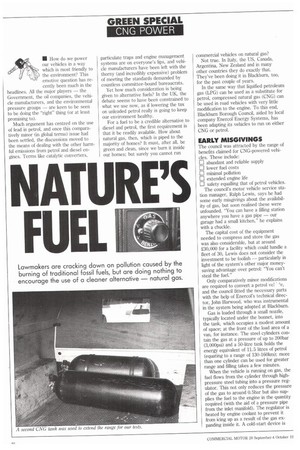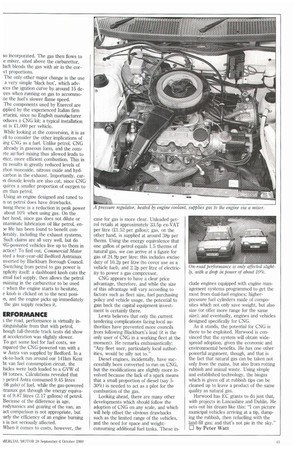GREEN SPECIAL CNG POWER
Page 40

Page 41

If you've noticed an error in this article please click here to report it so we can fix it.
IN How do we power our vehicles in a way which is most friendly to the environment? This emotive question has recently been much in the headlines. All the major players — the Government, the oil companies, the vehicle manufacturers, and the environmental pressure groups — are keen to be seen to be doing the "right" thing (or at least promising to).
Much argument has centred on the use of lead in petrol, and once this comparatively minor (in global terms) issue had been settled, the discussions moved to the means of dealing with the other harmful emissions from petrol and diesel engines. Terms like catalytic converters, particulate traps and engine management systems are on everyone's lips, and vehicle manufacturers have been left with the thorny (and incredibly expensive) problem of meeting the standards demanded by countless committee-bound bureaucrats.
Yet how much consideration is being given to alternative fuels? In the UK, the debate seems to have been constrained to what we use now, as if lowering the tax on unleaded petrol really is going to keep our environment healthy.
For a fuel to be a credible alternative to diesel and petrol, the first requirement is that it be readily available. How about natural gas, then, which is piped to the majority of homes? It must, after all, be green and clean, since we burn it inside our homes; but surely you cannot run commercial vehicles on natural gas?
Not true. In Italy, the US, Canada, Argentina, New Zealand and in many other countries they do exactly that. They've been doing it in Blackburn, too, for the past couple of years.
In the same way that liquified petroleum gas (LPG) can be used as a substitute for petrol, compressed natural gas (CNG) can be used in road vehicles with very little modification to the engine. To this end, Blackburn Borough Council, aided by local company Enercol Energy Systems, has been adapting its vehicles to run on either CNG or petrol.
The council was attracted by the range of benefits claimed for CNG-powered vehicles. These include: O abundant and reliable supply 0 lower fuel costs O minimal pollution O extended engine life O safety equalling that of petrol vehicles.
The council's motor vehicle service station manager, Ralph Lewis, says he had some early misgivings about the availability of gas, but soon realised these were unfounded. "You can have a filling station anywhere you have a gas pipe — our garage had a small kitchen," he explains with a chuckle.
The capital cost of the equipment needed to compress and store the gas was also considerable, but at around E30,000 for a facility which could handle a fleet of 30, Lewis does not consider the investment to be foolish — particularly in light of the system's other major moneysaving advantage over petrol: "You can't steal the fuel."
Only comparatively minor modifications are required to convert a petrol vel and the council fitted the necessary parts with the help of Enercol's technical director, John Harwood, who was instrumental in the system being adopted at Blackburn.
Gas is loaded through a small nozzle, typically located under the bonnet, into the tank, which occupies a modest amount of space; at the front of the load area of a van, for instance. The steel cylinders contain the gas at a pressure of up to 200bar (3,000psi) and a 50-litre tank holds the energy equivalent of 11.5 litres of petrol (equating to a range of 130-160km); more than one cylinder can be used for greater range and filling takes a few minutes.
When the vehicle is running on gas, the fuel flows from the cylinder through highpressure steel tubing into a pressure regulator. This not only reduces the pressure of the gas to around 0.5bar but also supplies the fuel to the engine in the quantity required (with the aid of a pressure pipe from the inlet manifold). The regulator is heated by engine coolant to prevent it from icing up as a result of the gas expanding inside it. A cold-start device is so incorporated. The gas then flows to e mixer, sited above the carburettor, hich blends the gas with air in the cortct proportions.
The only other major change is the use a very simple 'black box', which advices the ignition curve by around 15 deees when running on gas to accommote the fuel's slower flame speed. The components used by Enercol are ipplied by the experienced Italian firm irtarini, since no English manufacturer oduces a CNG kit; a typical installation 1st is £1,000 per vehicle.
While looking at the conversion, it is as ell to consider the other implications of ing CNG as a fuel. Unlike petrol, CNG already in gaseous form, and the cornetc air/fuel mixing thus allowed leads to der, more efficient combustion. This in rn results in greatly reduced levels of rbon monoxide, nitrous oxide and hydcarbon in the exhaust. Importantly, cu
m dioxide levels are also cut, since CNG quires a smaller proportion of oxygen to irn than petrol.
Using an engine designed and tuned to
n on petrol does have drawbacks. nong these is a reduction in peak power about 10% when using gas. On the her hand, since gas does not dilute or ntaminate lubrication oil like petrol, enle life has been found to benefit conlerably, including the exhaust systems. Such claims are all very well, but do VG-powered vehicles live up to them in actice? To find out, Commercial Motor sted a four-year-old Bedford Astramax averted by Blackburn Borough Council. Switching from petrol to gas power is nplicity itself: a dashboard knob cuts the rmal fuel supply, then allows the petrol maining in the carburettor to be used when the engine starts to hesitate, e knob is clicked on to the next posiin, and the engine picks up immediately the gas supply reaches it.
the road, performance is virtually intinguishable from that with petrol, hough full-throttle track tests did show A acceleration was slightly slower. To get some feel for fuel costs, we mpared the CNG-powered van with a w Astra van supplied by Bedford. In a ck-to-back run around our 141km Kent ht van fuel consumption circuit, the hides were both loaded to a GVW of 18 tonnes. Calculations revealed that e petrol Astra consumed 9.45 litres 08 gals) of fuel, while the gas-powered tramax got through the energy equivait of 9.87 litres (2.17 gallons) of petrol. Because of the difference in age, rodynamics and gearing of the van, an act comparison is not appropriate, but :arly the efficiency of an engine burning s is not seriously affected.
When it comes to costs, however, the case for gas is more clear. Unleaded petrol retails at approximately 33.5p ex-VAT per litre (£1.52 per gallon); gas, on the other hand, is supplied at around 38p per therm. Using the energy equivalence that one gallon of petrol equals 1.5 therms of natural gas, we can arrive at a figure for gas of 24,9p per litre: this includes excise duty of 10.2p per litre (to cover use as a vehicle fuel), and 2.2p per litre of electricity to power a gas compressor.
CNG appears to have a clear price advantage, therefore, and while the size of this advantage will vary according to factors such as fleet size, fuel purchasing policy and vehicle usage, the potential to gain back the capital equipment investment is certainly there.
Lewis believes that only the current tendering complications facing local authorities have prevented more councils from following Blackburn's lead (it is the only user of CNG in a working fleet at the moment). He remarks enthusiastically: "Any fleet user, particularly local authorities, would be silly not to."
Diesel engines, incidentally, have successfully been converted to run on CNG, but the modifications are slightly more involved because the lack of a spark means that a small proportion of diesel (say 530%) is needed to act as a pilot for the combustion of the gas.
Looking ahead, there are many other developments which should follow the adoption of CNG on any scale, and which will help offset the obvious drawbacks such as the limited range of the vehicles, and the need for space and weightconsuming additional fuel tanks. These in dude engines equipped with engine management systems programmed to get the most from dual-fuel engines; higherpressure fuel cylinders made of composites which not only save weight, but also size (or offer more range for the same size); and eventually, engines and vehicles designed specifically for CNG.
As it stands, the potential for CNG is there to be exploited. Harwood is convinced that the system will obtain widespread adoption, given the economic and environmental benefits. He has one other powerful argument, though, and that is the fact that natural gas can be taken not only from the mains, but also from rotting rubbish and animal waste. Using simple and established technology, the biogas which is given off at rubbish tips can be cleaned up to leave a product of the same quality as natural gas.
Harwood has EC grants to do just that, with projects in Lancashire and Dublin. He sets out his dream like this: "1 can picture municipal vehicles arriving at a tip, dumping the rubbish, then refuelling with the land-fill gas; and that's not pie in the sky." 0 by Peter Watt














































































































